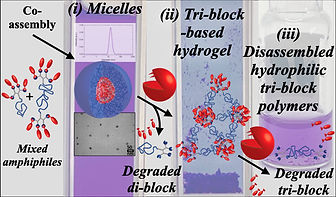In our lab, we study how chemical and physical information can be incorporated into nano and microscale systems, and what is the relationship between information, structure and function.
Our research interests include:
-
Stimuli responsive micro and nanosystems
-
1-D to 3-D folding in the nanoscale
-
Reversible self-assembly
-
Chemical reactions in confined environments
-
Multi-compartmental organic and inorganic nanoparticles
-
Chemical information in micro and nanoscale systems




November 4, 2025
A joint work of the Golodnitsky and Sitt groups introduces novel strategy for one-step fabrication of a flexible lithium titanate oxide (Li4Ti5O12, LTO) anode directly on a copper current collector via electrospinning, eliminating the need for high-temperature post-processing. LTO/Li cells incorporating electrospun fiber LTO electrodes with 72 wt% active material loading deliver a high capacity and excellent cycling stability, offering a promising route toward the development of next-generation flexible and wearable energy storage devices.
May 7, 2025
Congrats Nicole and Shira! A joint work by the Amir and Sitt groups at TAU, published in Biomacromolecules, presents an electrospun polymeric fabric composed of enzyme-responsive di- and triblock copolymers that undergoes a hierarchical cascade of four distinct mesophases, from fibers to nanoscale micelles to hydrogel. and finally to complete dissolution. Moreover, the fibers can encapsulate hydrophobic agents, which are retained within the micelle and hydrogel phases, enabling their controlled release. This cascade demonstrates sophisticated hierarchical control, unlocking new opportunities for biomedical applications of programmable materials.
April 10, 2025
A joint work of the Adler-Abramovich and Sitt groups at TAU, and the Green Skin Engineering Laboratory at Sheba Medical Center, Tel Hashomer presents a novel approach to skin regeneration using an electrospun scaffold derived entirely from the patient's own cells. This fully autologous skin substitute offers enhanced stability, ease of handling, and promotes rapid wound healing, addressing key challenges in current skin grafting techniques. The system demonstrates significant improvements in healing outcomes, suggesting a promising advancement in personalized regenerative medicine
March 30, 2024
Can we build fabrics that will act as batteries? Edi Mados and the group demonstrate, in collaboration with the Golodnitsky Group, the formation of flexible fabrics that serve as battery components. These innovative fabrics incorporate a flexible cathode and current collector microfibers, achieving impressive performance levels. The research, published in the Journal of Power Sources, opens up exciting possibilities for applications ranging from “smart” textiles to flexible micro-batteries.
March 6, 2024
Biological systems often feature two-dimensional shape-morphing networks with intriguing physical properties. In Shiran's recent work, published in Soft Matter, we’ve created inhomogeneous networks using thermo-responsive microfibers. By strategically arranging fibers with varying responses, we achieve directional actuation. Notably, individual segments within the network exhibit either linear extension or buckling upon swelling, akin to Landau’s second-order phase transition. These microscale variations translate into observable macroscopic effects.
June 6, 2023
How can one control the architecture of a polymeric fiber in the nanoscale? Here we propose to couple spontaneous phase separation to a crosslinking reaction and perform both within a polymeric fiber. The result - polymeric fibers with surprising inner architectures!
Congratulations to Maya Molco for developing this fantastic system, which was just published in Polymers, and we can not wait to see what other systems we can get using this novel approach.
June 5, 2023
Congrats Nicole and Parul for this great work done in collaboration with Amir's group, showing how a combination of amphiphilic block copolymers can lead to different mesophases ranging from micelles to hydrogels depending on their chemical structures, hydrophilic/hydrophobic ratio, and relative concentration, and can be used for sequential enzymatically induced transitions from (i) micelles to (ii) hydrogel and finally to (iii) dissolved polymers.
July 7, 2022
One of the frustrating things in science is when Mother Nature decides to shove in and literally break down your perfect fibers. That’s what happened to Nicole Edelstein-Perdo, my joint student with Prof. Roey Amir, but she showed Mother Nature and published a great paper about it!
Congrats Nicole and the team for an exciting paper, in collaboration with Roey Amir’s and Roy Beck Barkai’s groups at Tel Aviv University, just published in Chemistry of Materials.
February 9, 2022
Together with the Markovich Lab, we present the transformation of thin polymer fibres and fabrics into conductive materials by in situ growth of a thin, optically transparent gold–silver nanowire (NW) mesh directly on the surface of polymer fibres. we show that the NW network morphology depends on the diameter of the polymer fibres, where at small diameters (1–2 μm), the NWs form a randomly oriented network, but for diameters above several micrometers, the NWs wrap around the fibres transversally. This phenomenon is associated with the stiffness of the surfactant templates used for the NW formation. The approach demonstrated in this work can be extended to other polymeric fibres and could be useful for various smart electronic textile applications.
February 3, 2022
We present the fabrication of highly-ordered 2D networks hierarchically constructed of thermoresponsive mesoscale polymeric fibers, which can exhibit morphing with microscale resolution. The morphing of such networks strongly dependson two intrinsic length scales - the fiber diameter and mesh size. Depending on these parameters, such fiber-networks exhibit one of two thermally driven morphing behaviors: i)the fibers stay straight, and the network preserves its ordered morphology; or ii) the fibers buckle and the network becomes messy and highly disordered. Notably, in both cases, the networks display memory and regain their original ordered morphology upon shrinking.












